Mt. Everest is the tallest mountain in the world and stands at an altitude of 8848.86m. Mt. Everest, which is also known as Sagarmatha in Nepal and Chomolungma in Tibet, lies in the Mahalangur Himal sub-range of the Himalayas. The tallest mountain in the world shares two countries, Nepal and Tibet, and with its stunning beauty, it invites thousands of travelers, trekkers, and climbers
Mount Everest is a focal point for initiatives to strike a balance between adventure and conservation in addition to being the height of human achievement and natural beauty. Climbing Everest presents challenges along the way, but the sensation of standing at the tallest point in the world draws numerous adventurer souls from time to time.
For years, reaching the summit of Everest by conquering numerous forthcoming challenges is a testament to human endurance and exploration. Numerous people display their mountaineering skills extensively to reach its summit. To behold the beauty from the top of the world, a lot of effort to be put in and the riveting journey will reward you with personal reflection and a great sense of achievement.
The mountain was first successfully climbed by Sir Edmund Hillary of New Zealand and Tenzing Norgay from Nepal on May 29, 1953. Since then, climbing Mt. Everest has become a symbol of conquering and human exploration. There are numerous options to seek Everest beauty, and it is by embarking on the Everest Base Camp Trek, Everest Expedition, and Everest Helicopter tour.
Geographical Location
Mt Everest’s geographic location is 27.9881° N latitude and 86.9250° E longitude. It is between Nepal and Tibet, an autonomous region of China. The gigantic mountain stands tall and spreads its wings across kilometers of range. It stretches across 2400 kilometers and is situated in the Mahalangur Himal range, which includes other stunning mountains like Lhotse, Makalu, and Nuptse. The Mahalangur Himalayan range spreads across five countries of South Asia, and they are Nepal, India, Bhutan, China, and Pakistan. The low-lying plains of the Indian subcontinent to the south and the Tibetan Plateau to the north are naturally divided by Mount Everest, which rises sharply above the surrounding terrain.
Topographical Features
Mt. Everest’s topographical features include steep faces, ridges, valleys, glaciers, and the presence of the surrounding mountains. Here are the detailed topographical features of Mt. Everest.
The summit of Mt. Everest
The summit of Mt. Everest is the roof of the world, and that stands at an altitude of 8848.86m. To reach the summit of Mt. Everest there are different routes or ridges. Mt. Everest is located between Nepal and Tibet, and summiting Everest can be done from either ridge in the country.
Major Ridges
The major ridges of Mt. Everest extend in different directions, and they are:
Northeast Ridge: This is the primary route to approach the summit of the tallest mountain in the world from the Tibetan side. There are numerous exposed sections through this route, and they are comprised of technical challenges. This includes the infamous Second Step, a nearly vertical rock face at about 8,600 meters (28,200 feet).
Southeast Ridge: This is another route to approach the summit of the tallest mountain in the world from the Nepal side. This is the most commonly used path to reach the summit of Everest and is more popular and easier compared to Northeast Ridge. This route is also known as South Col and includes key landmarks such as Balcony and Hillary Step.
The route of the southeast ridge includes a journey from Everest Base Camp to numerous camps like Camp I, Camp II, Camp III, Yellow Band, Geneva Spur, South Col (Camp IV), Balcony Station, Hillary Step, and finally, the summit of Everest. Although this ridge offers a straight route to the top, its steep gradient and exposure to strong winds provide serious difficulties that need to be mindful of.
West Ridge: This is another route that is less climbed due to the technical difficulties and presence of dangerous sections like Hornbein Couloir. It was first successfully ascended by an American, and due to the presence of steep gradients, exposure to high winds, and treacherous terrain, it is considered to be one of the most dangerous routes to the summit of Everest. The route takes you from Base Camp to Camp I, Camp II, West Shoulder, Camp III, West Ridge Proper, Hornbein Couloir, and the final summit push.
Glaciers and Ice falls
You’ll encounter numerous glaciers and icefalls during your journey to the top of the world. This includes the following glaciers and icefalls:
Khumbu Icefall
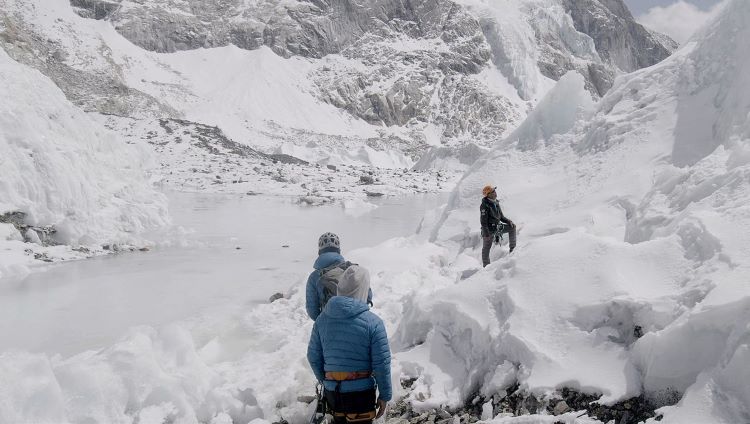
Khumbu Ice fall
- It is located at the foot of Western Cwm and is a part of Khumbu Glacier.
- It lies at an altitude of 5486m above sea level
- It is one of the most dangerous spots and consists of towering sacs and crevasses
- It is a technical section and demands extensive use of mountaineering tools like ladders, crampons, ropes, and others
Western Cwm
- It is a U-shaped valley that lies at the foot of Lhotse’s face
- It lies at an altitude of 6000m above sea level
- It is also known as the Valley of Silence and is also considered to be a challenging section of the Everest Expedition
- The Everest-Lhotse-Nuptse massif encloses it and offers a somewhat quiet and protected portion of the ascent.
Rongbuk Glacier
- It lies in the northern part of Everest and is divided into two parts, East and West Rongbuk Glacier
- These glaciers meet close to the Rongbuk Monastery after flowing down from the Everest range.
- North Col can be accessed via the East Rongbuk Glacier.
Significant peaks and valleys
The topography of Everest can also be added with numerous valleys and surrounding peaks. Some of them include Gokyo Valley and Khumbu Valley, along with sibling mountains of Everest. The significant peaks include Lhotse, Nuptse, and Ama Dablam, along with other notable peaks like Makalu, Pumori, Cho Oyu, and others.
Political boundaries
The two countries share the largest and tallest mountain in the world. Situating at the border of Nepal and Tibet, the political boundaries of Mt. Everest can be explained as:
Mt. Everest in Nepal
Mt. Everest lies in the Solukhumbu district of Nepal within the Sagarmatha National Park (a UNESCO World Heritage Site established in 1976). The park covers an area of 1,148 square kilometers and encompasses diverse flora and fauna of the region. Along with that, this includes Sherpa settlements, stunning landscapes, elevated hills, lush forests, and the distinct culture of the Sherpa people.
To visit the stunning mountainous landscapes and immerse in the distinct culture of the region, embarking on the Everest Base Camp Trek can be an excellent choice. This trek will take you through numerous culturally rich places like Lukla, Namche Bazaar, Tengboche, Dingboche, and others.
Mt. Everest in China (Tibet)
On the other side of Nepal, Mt. Everest is part of the Qomolangma National Nature Preserve. This is organized to protect the environment and cultural heritage of the region. The northern route to Everest starts from the Tibetan Plateau.
While the journey to the summit of Everest can be challenging through this route, it is usually less crowded and provides you with the outstanding beauty of Everest. On top of that, there is the presence of Rongbuk Monastery along the way, which presents you with spiritual insights. The journey to the summit of Everest stretches from North Base Camp to the summit through Intermediate camps, East Rongbuk Glacier, Northeast Ridge Proper, and the summit push.
Cultural Significance
The Everest Base Camp Trek or Everest Expedition takes you to the heartland and summit of Mt. Everest, respectively, through a cluster of sightseeing and culturally rich places. The journey offers you stunning mountainous beauty in response to the cultural exploration along the way.
When you’re on the journey, you pass through numerous places like Phakding, Namche Bazaar, Dingboche, Lobuche, Gorak Shep, and others that will give you insights into the Himalayan lifestyle and create an opportunity to immerse in the distinct culture of the region. Along the way, you’ll explore different monasteries, stupas, and mani walls while traversing through lush greenery, prayer flags, and prayer wheels. Some of the well-known monasteries that you’ll pass through are:
Tengboche Monastery
It is one of the famous monasteries of this region that lies at an altitude of 3867m. It is situated in Tengboche, one of the perfect spots to visit during the Everest Base Camp Trek. Tengboche Monastery is religiously rich and hosts numerous occasions, cultural practices, and festivals throughout the year.
Thame Monastery
Another famous monastery of the region is Thame Monastery. It lies in the village of Thame at an altitude of 3800m above sea level. It holds religious importance and conducts numerous cultural celebrations. Visiting this monastery will unveil your sense of spirituality and give you insights into Buddhist practices.
Khunde Monastery
Near Namche Bazaar, there is a village named Khunde, which offers the magnificent beauty of the Himalayas along with an excellent chance to explore the cultural practices of the region. In the village of Khunde, there lies a Khunde Monastery that serves as a place of worship and meditation for the visitors and locals. It was founded by Tenzing Norgay Sherpa, the first person to climb Mt. Everest.
Pangboche Monastery
Pangbocghe Monastery lies in the village of Pangboche, which is situated at an altitude of 3985m. Pangboche Monastery dates back several centuries, making it one of the oldest monasteries in the Everest region. During your journey to Everest Base Camp, you’ll pass through the village named Pangboche, where you can visit Pangboche Monastery and explore its cultural practices.
Khumjung Monastery
This is another famous and culturally preserved monastery near Namche Bazaar. It lies in Khumjung village that lies near Namche Bazaar. The acclimatization period on Namche Bazaar during the Everest Base Camp Trek will provide you with an opportunity to take a short hike and visit this monastery. Besides providing insights into the Sherpa culture and traditions, this region also serves you with excellent views of mountainous landscapes.
Namche Monastery
Namche Monastery is situated in the heart of the culturally rich village of Sherpa, Namche Bazaar. Namche Bazaar is the main trading center of this region and is culturally rich in many aspects. The astonishing journey will serve you with the perfect chance to explore the region’s diversity, cultural significance, and Buddhist practices. Despite being smaller than other monasteries, Namche Monastery is significant to the local Sherpa community’s religious and social life. It provides you insights into distinct cultures and spirituality with a peaceful retreat for meditation and prayer.
Popular Mount Everest Trekking Routes
Safety and Regulations
Climbing Permits
- Khumbu Pasang Lhamu Rural Municipality Entrance Permit that can be issued at Monjo in Solukhumbu district
- Sagarmatha National Park Entry Permit that can issued in the Nepal Tourism Board office, Kathmandu or Monjo
Physical fitness
- Strenous journey demands strong physical strength to overcome the forthcoming challenges. This is why it is necessary to perform lightweight ex
- Cardiovascular exercises like running, walking, cycling, hiking, swimming, and others will help you build stamina that will play a vital role during the journey
- Another important aspect of the physical fitness of this adventure is flexibility exercises. Performing stretching exercises and yoga will ensure your good mobility and provide you with a safe and hassle-free journey.
Necessary packing
Being equipped with necessary trekking and mountaineering tools is essential during the journey. Along with that, packing the bag with both summer and winter clothes is crucial, along with other essential items like first aid, toiletries, oxygen cylinders, and electronic gadgets.
Weather Monitoring
Summiting Everest demands checking the weather on a day-to-day basis. The adventure should only be carried out by monitoring the weather conditions. Fluctuating or unstable weather conditions can result in numerous threats, which is why it is essential to embark on the journey if the weather conditions are going to be stable.
Hiring guides
Hiring a guide is as important as any other aspect of summiting the tallest mountain in the world. The honed skills and experiences of a guide will surely come into role and aid in navigating the path. The journey comes with a lot of challenges, and having a well-known person beside you is essential.
Acclimatization
Proper acclimatization is important during any high Himalayan adventure. Acclimatizing properly means letting the body adapt to the changing surroundings. Adaptation of your body to your changing atmospheric pressure and oxygen level will let you have a smooth journey without the risks of catching altitude sickness. Also, be mindful of such conditions and take diamox along with you in case of uncertainties.
Proper Climbing Technique
Having prior mountaineering experience is crucial before heading for the Expedition. Climbers can face numerous challenges while ascending higher than Everest Base Camp. This is why proper use of mountaineering tools and possessing proper knowledge of climbing is essential. Use of Harnesses, Helmets, Ice Axe, Crampons, rope and other essential mountaineering tools is required.

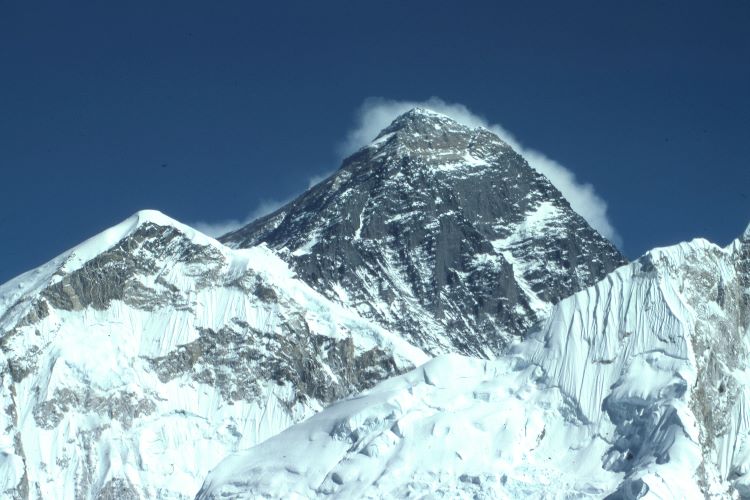


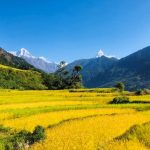 Saturday, October 18th, 2025
Saturday, October 18th, 2025
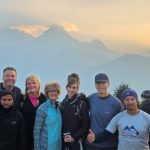 Friday, October 17th, 2025
Friday, October 17th, 2025
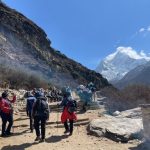 Tuesday, September 2nd, 2025
Tuesday, September 2nd, 2025
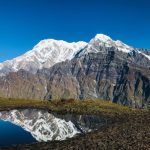 Saturday, August 30th, 2025
Saturday, August 30th, 2025
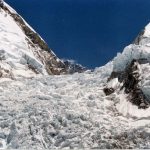 Wednesday, August 27th, 2025
Wednesday, August 27th, 2025
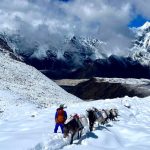 Wednesday, August 20th, 2025
Wednesday, August 20th, 2025
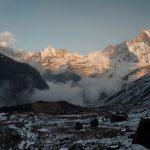 Wednesday, August 20th, 2025
Wednesday, August 20th, 2025
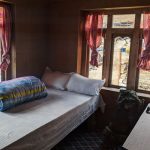 Monday, July 7th, 2025
Monday, July 7th, 2025
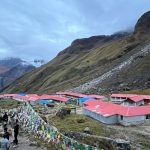 Thursday, July 17th, 2025
Thursday, July 17th, 2025
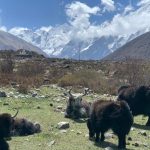 Monday, July 7th, 2025
Monday, July 7th, 2025
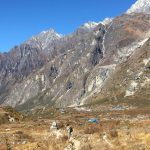 Saturday, June 14th, 2025
Saturday, June 14th, 2025
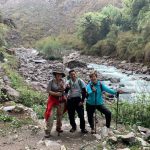 Wednesday, June 25th, 2025
Wednesday, June 25th, 2025
 Tuesday, August 5th, 2025
Tuesday, August 5th, 2025
